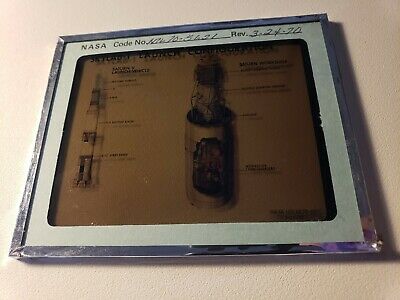-40%
NASA ORIGINAL GLASS SLIDE 3.25 X 4 IN - SKYLAB 1 - EX- NASA BOSS TOM PAINE #1
$ 105.59
- Description
- Size Guide
Description
[NASA, APOLLO PROGRAM, SPACE EXPLORATION, ASTRONAUTS]
We’re proud to offer this
NASA ORIGINAL GLASS SLIDE
measuring 3.25 in x 4 in of a cutaway conceptual view of the
SKYLAB 1,
the FIRST US SPACE STATION
in its launch configuration. The slide has a handwritten '
revision
date' of '
3/24/70
'.
This slide is from the personal effects of
former NASA ADMINISTRATOR THOMAS O. PAINE who led NASA'S first SEVEN MANNED APOLLO MISSIONS
.
This is one of a selection of original NASA slides we will have on offer over several weeks
.
Provenance:
This item is from the
Estate of Thomas O. Paine, the Administrator of NASA for the first 7 manned Apollo missions including Apollo 11
which of course culminated in landing the first men on the moon.
__________________________
Thomas Otten Paine (November 9, 1921 – May 4, 1992)
, an American engineer, scientist, and advocate of space exploration, was the third Administrator of NASA, serving from March 21, 1969 to September 15, 1970.
During his administration at NASA, the first seven Apollo manned missions were flown, including the first ever manned lunar landing by Apollo 11. Paine was also deeply involved in preparing plans for the post-Apollo era at NASA.
Born in Berkeley, California, Paine attended public schools in various cities and graduated from Brown University in 1942 with an A.B. degree in engineering. At Brown, Paine joined Delta Kappa Epsilon Fraternity. In World War II, he served as a submarine officer in the Pacific and in the subsequent Japanese occupation. He qualified as a Navy deep-sea diver and was awarded the Commendation Medal and Submarine Combat Insignia with stars. From 1946-49, Paine attended Stanford University, receiving an M.S. degree in 1947 and Ph.D. degree in 1949 in physical metallurgy. During his career, Paine received honorary doctor of science degrees from Brown, Clarkson College of Technology, Nebraska Wesleyan University, the University of New Brunswick, Oklahoma City University, and an honorary doctor of engineering degree from Worcester Polytechnic Institute.
Dr. Paine was appointed Deputy Administrator of NASA on January 31, 1968. Upon the retirement of James E. Webb on October 8, 1968, he was named Acting Administrator of NASA. He was nominated as NASA's third Administrator on March 5, 1969, and confirmed by the Senate on March 20, 1969.
Dr. Paine was recruited to succeed Mr. Webb by President Lyndon Johnson. He was tasked with the responsibility of getting the Apollo program back on track in the wake of the Apollo 1 disaster, and fulfilling President Kennedy's goal "before this decade is out, of landing a man on the Moon and returning him safely to the Earth."
During his administration at NASA, the first seven Apollo manned missions were flown, highlighted by the first ever manned lunar landing by Apollo 11. In all, 20 astronauts orbited Earth, 14 traveled to the Moon, and twelve walked upon its surface. Many automated scientific and applications spacecraft were also flown in U.S. and cooperative international programs.
Paine was also deeply involved in preparing plans for the post-Apollo era at NASA. Along with George Mueller and others, Paine developed an ambitious plan calling for the establishment of a lunar base and a massive space station in Earth orbit before the end of the 1970s, culminating in a manned mission to Mars as early as 1981. President Richard Nixon rejected these plans, however.
Apollo 11 Goodwill Messages
Paine was instrumental in acquiring the sentiments of world leaders that became the Apollo 11 Goodwill Messages which rest on the lunar surface today. He personally corresponded with the heads of what became seventy-three participating nations, and coordinated the efforts to enshrine their messages on a tiny silicon disc manufactured by the Sprague Electric Company of North Adams, Massachusetts. Paine's name is also etched onto the disc.
Paine proposed the idea of the messages to the State Department's Under Secretary for Political Affairs U. Alexis Johnson. A high level committee determined that a plaque declaring that "We Came in Peace for all Mankind" and the planting of a U.S. flag on the Moon were to be part of the ceremonial activities for Neil Armstrong and Buzz Aldrin on the lunar surface.
Please email any questions -











